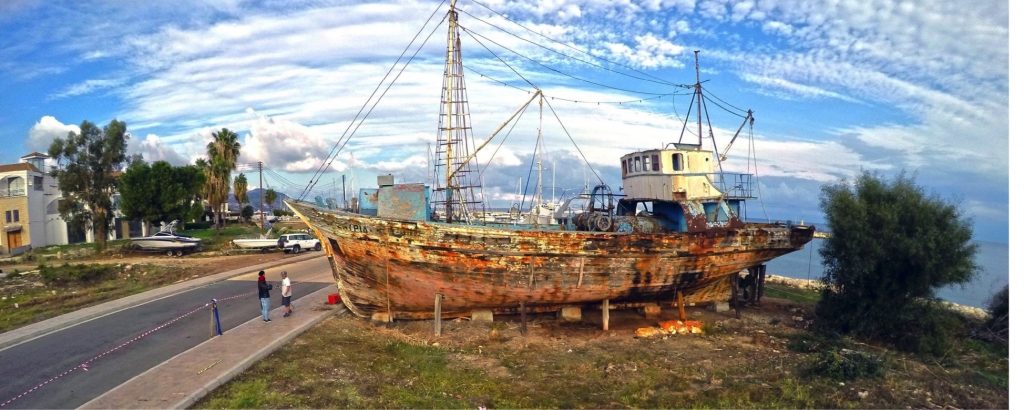Agios Spyridon - MARElab
Stella Demesticha and Constantinos Nicolaou
The wooden vessel AGIOS SPYRIDON, built in 1950 in Crete, was registered in Cyprus in 1954 and was used as a fishing trawler until 2004, when it was withdrawn. It belonged to the Aegean type of karavoskaro. After its withdrawal, authorities were convinced to keep it as a living monument of local maritime history and saved it from destruction, since it was one of the few large wooden trawlers surviving in the entire eastern Mediterranean. It was hauled outside its last port of dock, the marina of Latsi, Polis Chrysochous, on the northwest coast of the island, where it remained dry-docked for 15 years, uncovered and roughly supported. Despite the initial commitment, no action has ever been taken by the local authorities for its maintenance, so the deterioration of the structure was only a matter of time. In 2018, the newly elected municipal council decided that the vessel should be destroyed for safety and aesthetic reasons, effective immediately.

After MARELab’s intervention between March and May 2018, a rescue mission was organised and funded by the University of Cyprus and the Cyprus Institute (CyI), during which a 3D model was created (EPHEMERA). Failing to convince authorities to save the vessel, controlled destruction and full recording were deemed as the only ways to mitigate the consequences of AGIOS SPYRIDON’s loss. A funding request was approved by the Honor Frost Foundation, complemented with contributions from the municipality of Polis Chrysochous and the Cypriot Department of Fisheries and Marine Research.
The first and most demanding phase of the project, concerning the controlled dismantling and in situ recording of the vessel, was completed in two weeks (28/11 – 12/12/2019). Under an extremely tight and stressful schedule, and without any previous experience to build on, the team succeeded in fully recording the vessel, using conventional measurements and digital technology (laser scanning and photogrammetry). A full set of drawings and plans, both in 2D and 3D, were executed and its basic dimensions were recorded with accuracy during the project: overall length= 23.88m; keel length= 18.8 m, maximum beam= 6.16 m; midship height=3.26 m.
The project AGIOS SPYRIDON was the first experimental controlled destruction of a traditional vernacular wooden vessel in the eastern Mediterranean. Among the key issues addressed concerns the role of legislation but also of local authorities in the protection of historic and traditional wooden vessels. The case of AGIOS SPYRIDON exemplified the fact that, apart from legislative measures, the role of local communities is imperative.
Thus, apart from recording, raising awareness of the preservation of nautical heritage was one of the project’s main objectives. To this end, a Facebook page was created and kept updated almost on a daily basis. Wishing to preserve as much of the material remains of the vessel as possible, artists and craftspeople were also invited to choose broken pieces of the boat that would inspire them. Moreover, all recorded parts of the boat are used in a digital application now under development during another project (MARE CYPRIUM).
Brief background on fishing with the use of trawls
Fishing with the use of fishing nets (trawls) pulled along the bottom of the sea or in midwater has been known since antiquity, as gripos (γρίπος in Greek). According to written sources and depictions, the trawls were laid in the sea and then the net was slowly hauled in from both ends. Fishing with trawls began with oared vessels (trawlers), then with sailing (sail-trawlers) and more recently with engine-propulsion vessels (engine-trawlers). Engine-trawlers had to be sturdily constructed vessels with massive engine power in order to pull the nets as long as was needed to regularly complete the fishing procedure. Thus, the development of the fishing practice itself has also been directly connected with changes in traditional shipbuilding and navigation.
In Cyprus, the first use of engine-trawlers was documented in the early 1920s. Ever since, the specific method was used with traditional fishing gear, which was gradually replaced with modern electrical or hydraulic systems. However, the use of traditional trawlers has never been recorded in Cyprus, or anywhere else in the eastern Mediterranean. Thus, the study and recording of a traditional trawler will set the basis for the study and recording of other trawlers of the area as well.
Agios Spyridon preserved elements of a long wooden shipbuilding tradition, including: (i) wooden parts designed and constructed with traditional methods not used today, (ii) skeleton and reinforcing wooden parts with natural intensive curves, (iii) pegged joints as they were used on ships in antiquity, as well as metal joints found to be used at least since the Byzantine period, (iv) sealing techniques like caulking and tarring used for centuries in the Mediterranean and beyond. Moreover, all the original equipment of the vessel, including the engine and the propulsion system as well as the traditional fishing gear, was also preserved. Agios Spyridon was one of the last large traditional fishing vessels extant, and a living material evidence of the recent traditional nautical technology that is gradually disappearing. For all these reasons, the vessel constituted a unique monument in the local nautical tradition.
